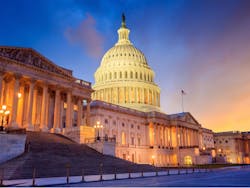A California congressman has introduced a bill into the US House of Representatives that would create a 30% microgrid tax credit.
The tax credit would run through 2025 and then phase down each year to 10% by 2028 and sunset in 2029.
Unlike existing federal tax credits for wind and solar, the microgrid tax credit could be taken as a direct payment by governments and nonprofits.
“Expanding and deploying microgrids can harness clean energy sources, keep our homes and critical infrastructure connected when the larger grid fails, and lead to reliable and consistent electricity for our homes and safety for our communities,” Rep. Jimmy Panetta, D-Calif., the bill’s sponsor, said April 13.
To qualify for the tax credit, the microgrid must include a microgrid controller and have generating capacity ranging from 4 kW to 50 MW. The microgrid cannot include equipment that is part of the bulk power system, but the bill allows the Energy Department secretary to waive that requirement.
The bill — called the Making Imperiled Communities Resistant to Outages with Generation that is Resilient, Islandable and Distributed Act, or MICROGRID Act — comes as the Biden administration is proposing a massive investment in renewable energy and grid resilience through infrastructure legislation.
Bill joins Biden clean energy tax proposals
Biden’s infrastructure plan includes a 10-year extension of production and investment tax credits for renewable energy generation and fuel cells. The plan extends the tax credit to energy storage. It also creates a tax incentive for producing hydrogen using carbon-free electricity. Biden also wants to provide a direct pay alternative to the tax credits.
Tax credits have been an effective policy mechanism for supporting the deployment of advanced energy technologies, according to Leah Rubin Shen, federal policy director for Advanced Energy Economy, a trade group.
Join us at Microgrid 2021 for a special panel discussion, “Why Does a Microgrid Cost What It Costs?,” 1 p.m. EST, May 20. Admission is free if you register in advance. However, the virtual platform caps registrations, so we urge you to register now.
The inclusion of a direct pay option in the bill is particularly helpful, as increased pressure on the tax equity market is making it difficult to use existing tax credits, Rubin Shen said.
“The reliable and resilient grid of the future will require deploying a wide range of diverse technologies — including microgrids — and we are optimistic that all of those technologies will be part of the legislation emerging from Congress,” Rubin Shen said.
Microgrid tax credit gets wide support
Companies such as Bloom Energy, Concentric Power, Scale Microgrid Systems and Schneider Electric North America are backing the bill.
“Renewable energies connected by microgrids can transform legacy infrastructure into a resilient power grid that offers reliable access and backup power for our most vulnerable, frontline communities,” said Annette Clayton, Schneider Electric CEO and president.
Organizations supporting the bill include the National League of Cities, the United States Conference of Mayors, the American Public Power Association, the National Rural Electric Cooperative Association, the Native American Finance Officers Association and the Rural Community Assistance Partnership.
The tax credit bill could provide a financial boost to a 35-MW microgrid project in Gonzales, California, being developed by Concentric Power.
“There is no doubt that California’s infrastructure needs significant investment, and, on a small scale, supporting the MICROGRID Act to incentivize the buildout and deployment of microgrids is absolutely necessary as a base element of infrastructure and improvement in California,” Gonzales Mayor Jose Rios said.
Follow Microgrid Knowledge on LinkedIn.







